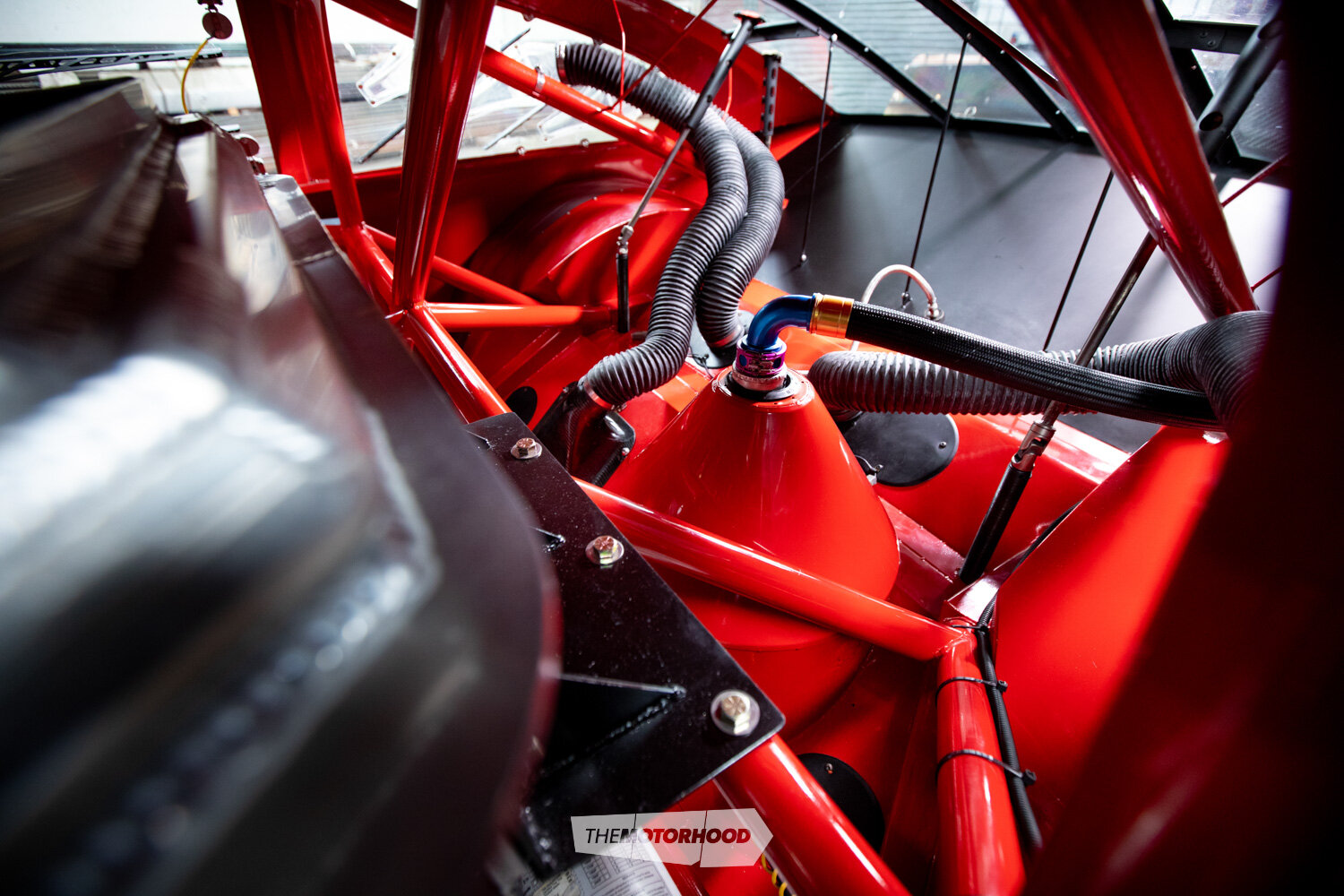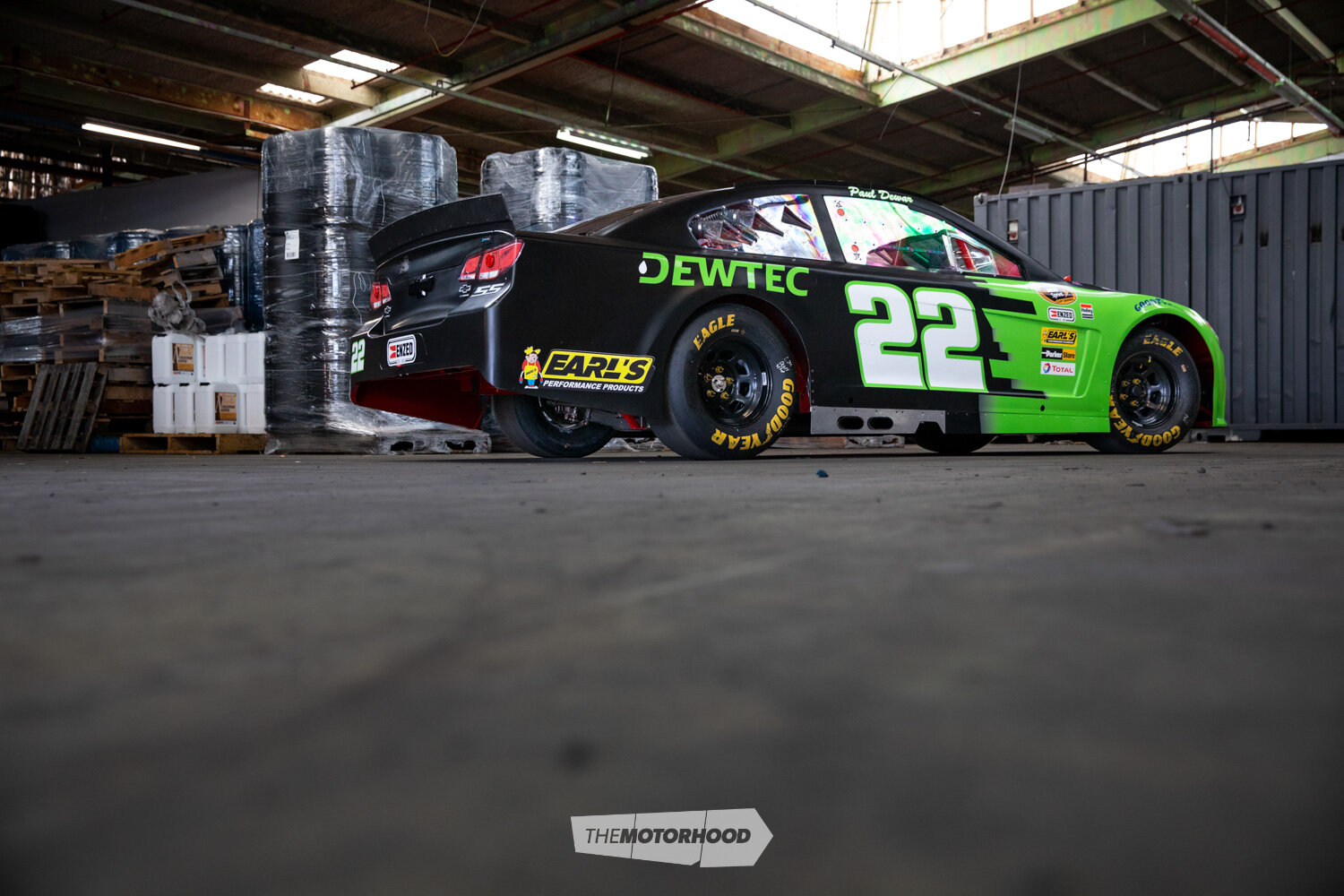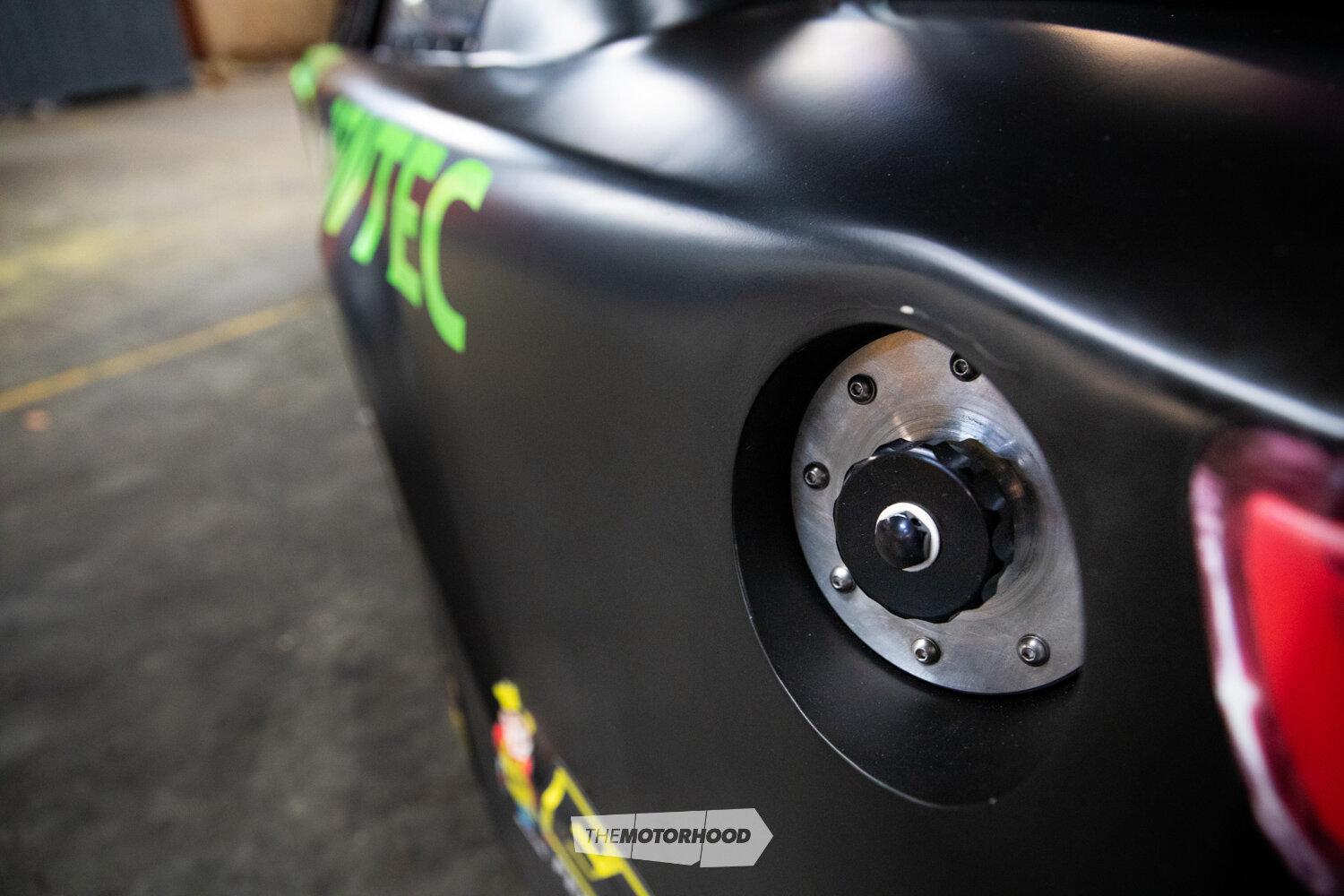Built for battle on the high banks of tracks like Daytona or the Brickyard, this Nascar duo can now be found banging doors in the Manawatu
Words: Marcus Gibson Photos: Aaron Mai

Spec
2007 Dodge Charger
Nascar
Engine: Penske Dodge R5/P7 Nascar 358ci, billet steel rods, forged pistons, billet steel crankshaft (possibly Winberg), Barnes five-stage dry-sump oil pump, Moroso stainless-steel segmented dry-sump oil pan with piston oilers, Mopar P7 CNC-ported cylinder heads, Jesel shaft-mount roller rocker arms, Dodge aluminium valve covers with spring oilers, Edelbrock ported intake manifold, 900cfm Holley race carb, CV Products billet mechanical fuel pump, twin MSD ignition system with 9000rpm limiter, Dodger R5 stainless-steel headers, 3.5-inch twin exhaust system (mufflers fitted for New Zealand), 32psi cooling system with large alloy radiator (inbuilt oil cooler)
Driveline: Jerico four-speed close-ratio gearbox, steel flywheel, seven-inch triple-plate clutch, Penske nine-inch Ford diff, Nodular iron case, Detroit locker, steel billet yoke, 4.11-ratio isotronic process on gears, 31-spline, large bearing, internal oil pump, oil cooler, Nascar four-inch steel driveshaft with forged steel yokes
Chassis: 1020 DOM tube Penske 2007 COT chassis, 17-gallon (64-litre) Kevlar fuel cell
Suspension: (F) Penske Racing seven-inch single-adjustable damper, 5.5-inch 1200-pound (544kg) Eibach coil springs with height adjusters, double-wishbone (adjustable camber and caster), two-inch hollow-bar 1400-pound (635kg) sway bar; (R) Penske Racing seven-inch single-adjustable damper, five-inch 600-pound (272kg) Eibach coil springs, two-link live-axle design with truck-type adjustable trailing arms, adjustable Panhard bar, ¾-inch 150Ib (68kg) sway bar
Brakes: Adjustable pedal box, AP cylinders; (F) PFC four-pot calipers, PFC 12.37×1.125-inch ventilated rotors, carbon-fibre brake vent ducts; (R) AP Racing four-pot calipers, PFC 12.25×1-inch rotors
Wheels/Tyres: (F) 15×9.5-inch Aero 59 Series steel race, Hoosier 27.5×11.5R15; (R) 15×9.5-inch Aero 59 Series steel race, Hoosier 27.5×11.5R15
Exterior: Penske hand-built steel Nascar Dodge Charger body with fibreglass nose and tail section, Lexan screens, roof and bonnet spin flaps, Penske Pennzoil wrap
Interior: Steel 1020 DOM tube Nascar COT-spec roll cage, Kirkey full-containment race seat, Auto Meter Pro-Comp Ultra-Lite gauges, Simpson harness
Performance: 780hp at 9000rpm
Times: 1min 13.7s (Manfeild)
Like many things from the land of opportunity, American motorsport is something that has long had a big-brother influence on what happens here in New Zealand. Right from the earliest events held here in the ’20s, it wasn’t long before an American Stutz was imported and promptly began to dominate. Soon after we’d been introduced to open-wheel speedway, drag racing emerged, and from that point the floodgates truly opened. Just look at the motorsport landscape here today — you can’t go far without seeing how what has happened on the eastern side of the Pacific has shaped our motorsport landscape. We’re not alone, either, as there are plenty of other countries who have adopted this motorsport way of life.


But not all American motorsports have become global. In fact, any attempts to globalize Nascar have never really fired on all cylinders, meaning that the only time you’ll be lucky enough to watch a race of these tin-top stock cars is by flicking on pay-per-view TV or hopping on a big bird to cross the sea and purchasing a ticket to sit in the likes of the 235,000-seat Indianapolis Motor Speedway.
For Paul Dewar, American motorsport has always been alluring, having raced the dirt ovals in sprint cars and modifieds for a decade, even earning a 1NZ back in the ’90s. Today, his son has taken to the dirt too, also earning a 1NZ for the tail tank of his microsprint. It’s also become a regular thing for Paul and mates to cross the Pacific to witness the sports they love first-hand, which is where Paul picked up what we’d call the ultimate souvenir. He explains: “We were at an SRI in Mooresville, NC, US, a shop that sells used Nascar parts, and they happened to have a car on display. We looked at it and asked if it was for sale and if so, how much? The price was just too good not to, so the next day I owned it.”
That was the older of Dewar’s two Nascars — the 2007 Dodge Charger, built by none other than Penske Motorsport and wearing the tag ‘Number 22’. A COT chassis, it was raced in 2008 and 2009 by three-time IndyCar champ Sam Hornish Jr. It was then parked until it was updated to 2012 bodywork when Joey Legano signed to the team and it served as his practice and promotional car. It remains in these colours today. The tricky thing about purchasing used Nascars is the type of racing they’re built for. Such is the competitiveness of the sport that the teams build cars specifically to suit each type of track, so, typically, there are three different types of car. This particular machine was built as a Superspeedway car, which means it’s been optimized to do one thing and that’s go left — flat out.


This means that dozens of changes made, some as big as the suspension geometry and some as small as where the fire-extinguisher bottle is mounted. But with no such tracks here in New Zealand, it did mean Paul would need to purchase a bunch of parts so they could convert it to a road-course car, including a new diff housing, as they run different camber angles on both sides.

While some of the changes were straightforward, others were not so. “It was considerably more work than we thought it would be. We bought it with some parts like the diff housing and suspension arms, but they didn’t fit, even though it was for the same year; they have so many types of cars,” Paul says. The solution was to get a set made locally. The suspension was also swapped out for stiffer items. And despite the fact that it didn’t come set up to turn right, the first few times Paul drove the car, it surprised him just how good it was right out of the box — although coming to grips with the lack of lock took some getting used to.

Ask anyone what they think the best thing about Nascar is, and 99.9 times out of hundred they will say the engines, and although there are many ex-Nascars floating around with retrofitted power plants of lesser calibre, this car retains the real-deal 358-cube Dodge R5P7 built by Penske. No matter how tough you think the small block under your hood is, it’s unlikely to hold a candle to the R5. We’re talking a specially cast dry-sumped block, billet crank, roller cam, shaft-mounted roller rockers, CNC heads — the list goes on and on and on. The exact contents, however, are still to be discovered, as the 750hp small block has yet to be taken apart. Like all race engines, they are highly strung and finicky, as you must have both the oil and water heated before start up, and the coolant system even runs at upwards of 32psi, which is double what your modern road car uses. This, in turn, increases the boil point to over 140°C.

If having one Nascar in the shed wasn’t enough, on a return trip to the US last year while shopping for Dodge spares, another right-place, right-time situation arose.
“A mate was looking for a Ford Nascar, so we asked if they knew of any for sale, when the guy standing in line behind us said he had one for sale back in his shop. We followed him to a big building with no signage and went inside to find Premium Racing, a three-car Nationwide Cup Series team,” explains Paul.
The only problem being the car wasn’t a Ford, it was a Chev, so his mate passed on the deal. Paul, however, couldn’t resist the temptation, opting to double down and get something much more late model.
Like the Dodge, this is also a COT machine, although a later, 2011 model built by Richard Childress Racing (RCR). After two years of racing, including a second place at Chicago with Kevin Harvick behind the wheel, it was sold to Tony Baldwin Racing, where it saw a further two years of action before a complete rebuild to later model panel work and an engine change to suit a proposed Canadian Nascar feeder series. This means that a slightly lower compression, bigger capacity Chev-based power plant now resides up front, built by PME Engines to the tune of 374ci. Unlike the unopened 358 in the Dodge, the contents of the bigger capacity PME Chev are well documented, starting with a Dart block, Mahle pistons, Callies six-inch steel rods, and ending with CNC-ported Brodix Heads, Manley valves, titanium retainers, coated PSI valve springs, and topped with a single-plane manifold and 830cfm Roush carb. And while it’s not a Cup engine, which at the time were making over the 800 mark, the 374 makes more than the R5, with a stout 780hp at around 9000rpm. Both cars run four-speed dogboxes and nine-inch live axles.
The biggest bonus with the new car was the fact that it came road-course ready, so there was no messing around trying to convert it over. However, as with the Dodge, hoops had to be jumped through to get it MotorSport New Zealand (MSNZ) legal. Sadly, Nascar is not recognized here, and getting the required paperwork out of the States was a real nightmare. As Paul puts it, his email requests to Penske wouldn’t even get past the office girl. With that car in particular, it was only through a back door (a friend of a friend working at Penske) that Paul was able to get his hands on the necessary paperwork, and in doing so also learn about the car’s history.





The Dodge has competed in five rounds of the Manfeild all-comers winter and summer series racing, smashing out a 1min 13.7s best lap, although it’s now going to retire from racing and become more of a shed piece to fire on occasion and perhaps take out for the odd squirt. This was the main driving force in getting a second and much later model car, as the parts required to keep the Chev on track are that much easier to find. Bodywork for Dodge is not off-the-shelf, whereas you can still buy complete — albeit fibreglass — Chev bodies out of the States if needed. Basically, everything is easily purchased, from brake rotors to replacement suspension. Where it does get a little tricky is tyres, as the real-deal Nascar Goodyears are not for sale to the public, so they are substituted with Hoosiers purchased direct from the US. Hoosier was once a Nascar supplier, although that stopped after the tyre wars in the ’80s/’90s.
Having arrived in plain black and with no livery to suit its newer late-model skin (it was a Budweiser car in its old form), the livery you see on it today is something of their own design, and it wears the number 22, much like the Legano car. It’s almost ready to hit Manfeild in the coming months, with Paul behind the wheel, for some more racing. So, if you ever wanted to see a real-deal Nascar pounding laps, this is your best opportunity, given the current border restrictions — it’s those restrictions that are also probably stopping Paul from shopping for more souvenirs.



Driver
Paul Dewar
Occupation: Hydraulics engineer
Location: Palmerston North
Previously owned cars: Raced for a lot of years a while ago, motocross, rally, speedway, and a bit of circuit racing
Dream Car: Aussie V8 Supercar, just to play with
Length of ownership: Chev — one year, Dodge — three years
This article originally appeared in NZV8 issue No. 187




